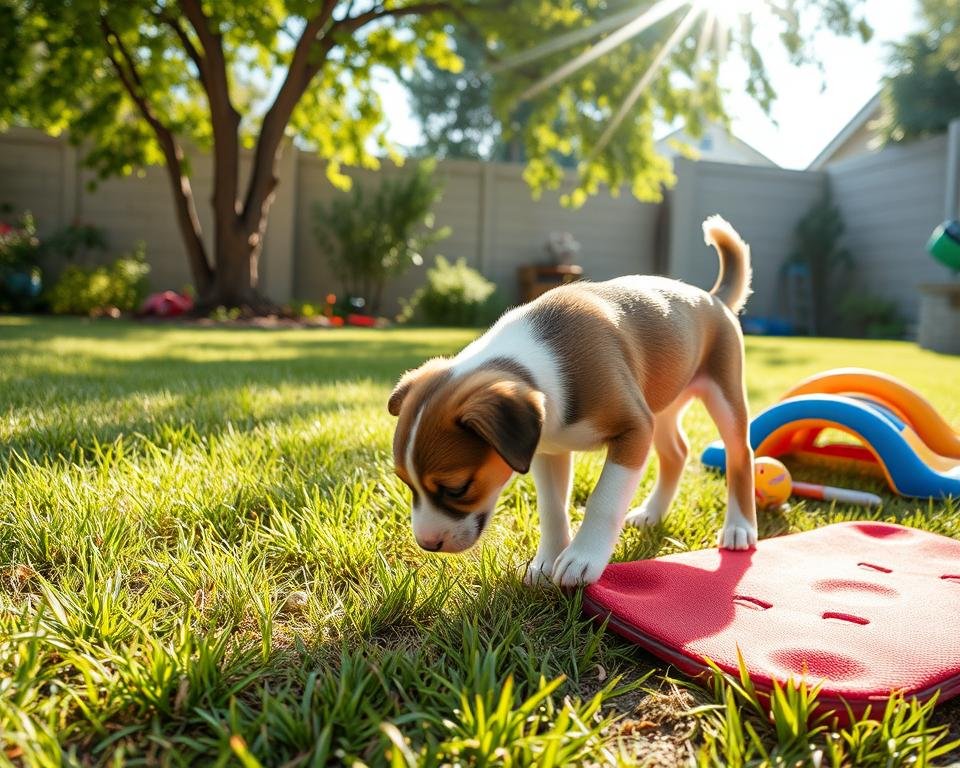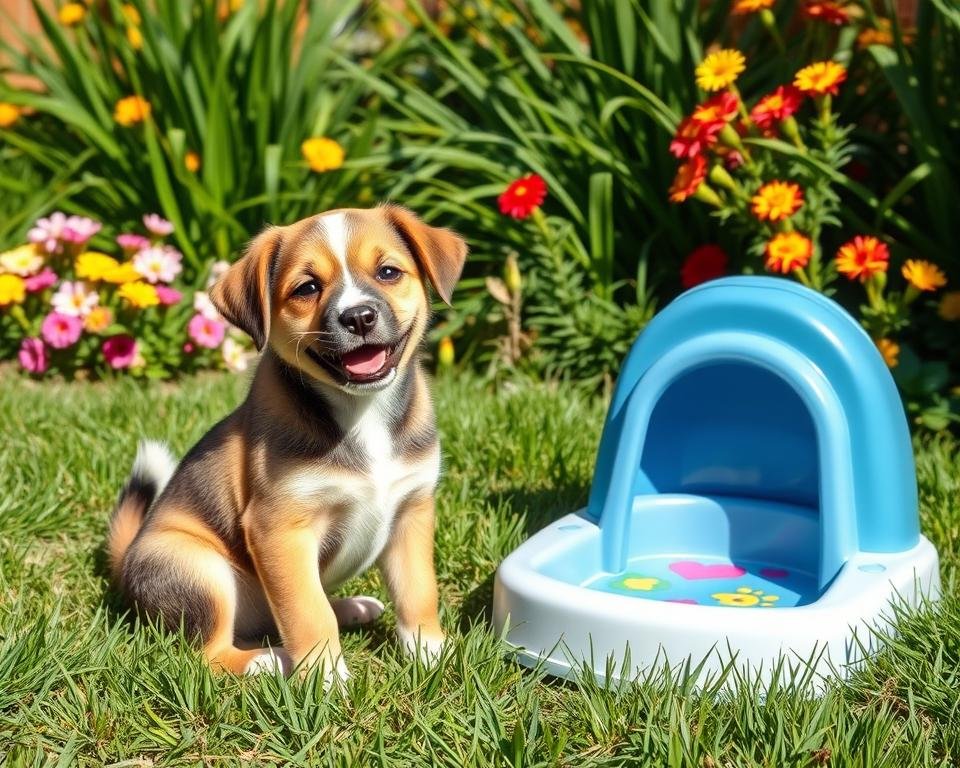Training a new puppy to use the toilet can seem tough. But, with the right steps, you can do it in just 7 days. Teaching your puppy to go potty where they should is key to being a good pet owner. This guide will help you, no matter if your puppy is small or big, to train them fast.
The time it takes to house train a puppy varies. It depends on the puppy’s size, personality, and how well you train them. Some puppies learn quickly, while others need more time. Knowing how puppies behave and sticking to a training plan can help you succeed in 7 days.
This guide covers the basics of potty training. We’ll talk about setting a routine, using positive rewards, and managing your puppy’s behavior. Whether you’re new to puppies or have experience, this guide will give you the tools to train your puppy quickly. This will make your puppy happy and your home clean and stress-free.
Understanding Puppy Potty Training Basics
Potty training a puppy is rewarding but can be tough. Puppies see the whole world as their bathroom. It’s important to teach them to use the right spot. Training takes weeks of steady effort to teach good habits.
Natural Puppy Behavior and Training Timeline
Puppies between 8 to 12 weeks are key for learning potty habits. By 12 weeks, they can hold it for 2 hours in a crate. As they get older, they can hold it longer, up to 4 hours at 6 months.
How Long Does House Training a Puppy Take
House training time varies, but it can be done in 7 days with effort. Puppies need breaks every 1-2 hours. They need one after waking, meals, naps, play, and before bed. A set feeding schedule and crate help a lot.
Essential Equipment for Successful Training
- Collar/Harness and Leash
- Dog Litter Boxes or Wee-Wee Pad Frames
- Wee-Wee Pads
- Treats
- Carpet Cleaner and Floor Cleaning Supplies
The right tools, like litter boxes and wee-wee pads, help a lot. Small breeds might take longer, so be patient and consistent.
Understanding a dog’s appetite andnutritional needs is also key for their health.

“Consistency, positivity, creating a routine, and using a crate are key elements for successful potty training.”
How to Toilet Train a Puppy in 7 Days
Toilet training a puppy can seem tough, but it’s doable in 7 days with the right steps. The secret to quick puppy training methods is being proactive, watching them closely, and rewarding them positively.
To start the 7-day puppy potty training journey, setting up a routine is key. Puppies love knowing what to expect, so a schedule for potty breaks helps them learn where to go.
- Take your puppy out every 30 minutes, using a leash to keep them close. Give them 5 minutes to do their business, and praise and treat them right after.
- Use tethering and crate training to watch your puppy and stop accidents. Puppies don’t like to go in their sleeping spots.
- Encourage good behavior by giving treats and praise when they go in the right spot. This teaches them that good habits are rewarded.
Consistency is the most important thing. Keep to a schedule and be patient as your puppy learns. With effort, you can toilet train your puppy in just 7 days.
“Establishing good potty training habits as early as 8 weeks old can facilitate a seven-day potty training program later on.”
By using these quick puppy training methods, you’re on your way to a clean, well-trained pup. Remember, patience and consistency are the keys to a successful 7-day puppy potty training journey.
Creating an Effective Potty Training Schedule
Creating a consistent potty training schedule is key to housebreaking your puppy. Puppies need to go out often, every 30-60 minutes during the day. This helps them follow their natural instinct to keep their den clean.
Optimal Potty Break Timings
Time your puppy’s potty breaks around their daily activities. Take them out after meals, playtime, and naps. This helps them learn to go outside after these activities. A consistent puppy potty schedule makes training smoother and faster.
Nighttime Training Routine
Nighttime potty training may need 1-2 outings to avoid accidents. Use a house training chart to track your puppy’s patterns. Adjust the schedule as needed. A regular feeding schedule helps regulate their bathroom break timings.
“Consistency, routine, positivity, and a crate are key elements to successful puppy potty training.”
By sticking to a structured puppy potty schedule and meeting their needs quickly, you can help your puppy succeed. Stay patient and positive, and your puppy will learn to be fully house-trained.
When Should a Puppy be Potty Trained
Potty training a puppy is key to being a good pet owner. Start this process around 12 weeks of age when puppies can control their bladders better. But, you can start teaching them early, even at 8 weeks. The most important thing is to be consistent, as it may take weeks or months to fully train them.
The puppy training age is important, but so is the optimal potty training time. Puppies under 8 weeks need to go out every 45 minutes. Those 8-10 weeks old can wait 60 minutes. As they get older, you can wait longer, up to 120 minutes for puppies 12 weeks and older.
“Housebreaking problems are the #2 behavioral reason why dogs are surrendered to shelters in the US, second only to aggression.”
Being consistent is the key to successful potty training. Create a routine that includes taking your puppy out in the morning, after meals, after play, and before bed. Give them treats and praise when they do it right. And don’t worry about accidents – they’re part of learning.
The aim is to have zero accidents during training. By managing and preventing mistakes, then introducing training, you’ll get a well-behaved, house-trained puppy soon.
Positive Reinforcement Techniques and Rewards
Effective puppy potty training relies on positive reinforcement. When your pup goes in the right spot, reward them with treats and praise. This method encourages good behavior and strengthens your bond.
Using Treats and Praise Effectively
Give a small, high-value treat and praise your puppy right after they go. This feedback makes them more likely to do it again. Always follow this routine to keep things consistent.
Handling Accidents Properly
Accidents happen during puppy training. Don’t punish your pup. Clean the area with an enzymatic cleaner to remove scents. Then, take them back to their potty spot and start again.
Teaching Potty Cue Words
Use a specific cue word, like “go potty,” to teach your puppy. Say it every time you take them out. They’ll learn to associate the words with going potty.
Positive reinforcement, consistent rewards, and managing accidents are key to toilet training. With patience and dedication, you can help your pup through this important step.
Crate Training and Confinement Methods
Puppy crate training is a great way to help with potty training. Crates give your puppy a safe place and teach them bladder control. Make sure the crate is the right size – big enough for them to move around and lie down.
Keep crate time short, except at night. This helps your puppy learn to hold their bladder. For longer times, use confinement areas with potty pads to avoid accidents.
- Choose a crate size that allows your puppy to stand up, turn around, and lie down comfortably.
- Place the crate in a quiet, low-traffic area of your home.
- Introduce your puppy to the crate gradually, using positive reinforcement and treats.
- Ignore any whining or barking from the crate, as responding to these behaviors can reinforce them.
- Maintain a consistent schedule for taking your puppy out of the crate for potty breaks.
Consistency is key in confinement techniques for potty training. A safe and predictable environment helps your puppy learn. This way, you’ll be on the path to successful crate training.
“Crate training is a popular method for house training dogs, as it capitalizes on their instinct to keep their living space clean.”
How to Train a Potty Train a Puppy
Potty training a puppy is one of the most essential tasks a new pet owner will face and, when done correctly, can lead to a harmonious living environment. Knowing how to train a puppy to go potty in the right place is crucial for both the pup’s well-being and your household’s cleanliness. Start by establishing a consistent routine; take your puppy outside first thing in the morning, after meals, and before bedtime. Puppies have small bladders and may need to go out as often as every hour, especially in the early stages. Being vigilant and observing their behavior will help you identify signs that they need to relieve themselves.
The key to successfully potty training a puppy lies in positive reinforcement. When your puppy eliminates outside, be sure to praise them enthusiastically and offer them a treat. This positive association will encourage them to continue going outside. It’s also essential to minimize the risk of accidents inside the house by keeping a close eye on your puppy. If you notice them sniffing around or circling, take them out immediately. If they do have an accident indoors, do not scold them; instead, clean the area thoroughly to remove any lingering odors that might encourage repeat behavior.
When should a puppy be potty trained? Many experts suggest starting as soon as you bring your puppy home, as young as eight weeks old. However, it’s important to remember that every puppy is different. Some may take longer to understand the concept of potty training. Patience and consistency are your best tools, as puppies thrive on routine and repetition. As your puppy becomes accustomed to the schedule, you can gradually lengthen the time between bathroom breaks.
Finally, making use of specific phrases or commands when you take your puppy outside can facilitate faster learning. Choose a command that feels natural and use it consistently whenever you take them out. This will help them associate the command with the action of going to the bathroom. Over time, and with a bit of love and patience, you’ll find that your puppy learns how to potty train successfully, bringing you one step closer to a stress-free and clean home.
Conclusion
Successful puppy potty training needs consistency, patience, and positive feedback. A regular schedule, the right confinement, and rewards for good behavior help a lot. Every puppy is unique, so it might take longer than 7 days for some.
Keeping a steady routine for meals and bathroom breaks is essential. Positive feedback, like treats and praise, encourages puppies to go outside. This makes them more likely to repeat the good behavior.
Trying to train a puppy in just seven days is ambitious. The time it takes can change a lot based on the puppy’s age, breed, and how consistent and patient you are. The key is to stay positive and be ready for any challenges that come up.



